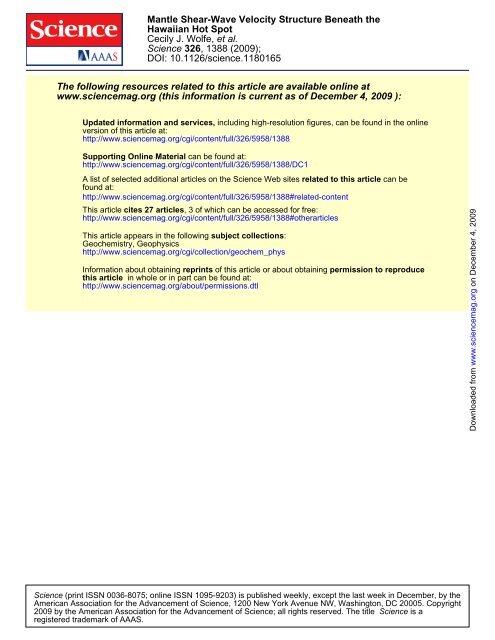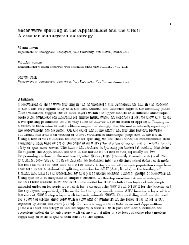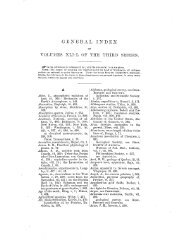Mantle Shear-Wave Velocity Structure Beneath the Hawaiian Hot Spot
Mantle Shear-Wave Velocity Structure Beneath the Hawaiian Hot Spot
Mantle Shear-Wave Velocity Structure Beneath the Hawaiian Hot Spot
You also want an ePaper? Increase the reach of your titles
YUMPU automatically turns print PDFs into web optimized ePapers that Google loves.
<strong>Mantle</strong> <strong>Shear</strong>-<strong>Wave</strong> <strong>Velocity</strong> <strong>Structure</strong> <strong>Beneath</strong> <strong>the</strong><strong>Hawaiian</strong> <strong>Hot</strong> <strong>Spot</strong>Cecily J. Wolfe, et al.Science 326, 1388 (2009);DOI: 10.1126/science.1180165The following resources related to this article are available online atwww.sciencemag.org (this information is current as of December 4, 2009 ):Updated information and services, including high-resolution figures, can be found in <strong>the</strong> onlineversion of this article at:http://www.sciencemag.org/cgi/content/full/326/5958/1388Supporting Online Material can be found at:http://www.sciencemag.org/cgi/content/full/326/5958/1388/DC1A list of selected additional articles on <strong>the</strong> Science Web sites related to this article can befound at:http://www.sciencemag.org/cgi/content/full/326/5958/1388#related-contentThis article cites 27 articles, 3 of which can be accessed for free:http://www.sciencemag.org/cgi/content/full/326/5958/1388#o<strong>the</strong>rarticlesThis article appears in <strong>the</strong> following subject collections:Geochemistry, Geophysicshttp://www.sciencemag.org/cgi/collection/geochem_physInformation about obtaining reprints of this article or about obtaining permission to reproducethis article in whole or in part can be found at:http://www.sciencemag.org/about/permissions.dtlDownloaded from www.sciencemag.org on December 4, 2009Science (print ISSN 0036-8075; online ISSN 1095-9203) is published weekly, except <strong>the</strong> last week in December, by <strong>the</strong>American Association for <strong>the</strong> Advancement of Science, 1200 New York Avenue NW, Washington, DC 20005. Copyright2009 by <strong>the</strong> American Association for <strong>the</strong> Advancement of Science; all rights reserved. The title Science is aregistered trademark of AAAS.
REPORTS<strong>Mantle</strong> <strong>Shear</strong>-<strong>Wave</strong> <strong>Velocity</strong> <strong>Structure</strong><strong>Beneath</strong> <strong>the</strong> <strong>Hawaiian</strong> <strong>Hot</strong> <strong>Spot</strong>Cecily J. Wolfe, 1 * Sean C. Solomon, 2 Gabi Laske, 3 John A. Collins, 4 Robert S. Detrick, 4John A. Orcutt, 3 David Bercovici, 5 Erik H. Hauri 2Defining <strong>the</strong> mantle structure that lies beneath hot spots is important for revealing <strong>the</strong>ir depthof origin. Three-dimensional images of shear-wave velocity beneath <strong>the</strong> <strong>Hawaiian</strong> Islands, obtainedfrom a network of sea-floor and land seismometers, show an upper-mantle low-velocity anomalythat is elongated in <strong>the</strong> direction of <strong>the</strong> island chain and surrounded by a parabola-shapedhigh-velocity anomaly. Low velocities continue downward to <strong>the</strong> mantle transition zone between410 and 660 kilometers depth, a result that is in agreement with prior observations of transitionzonethinning. The inclusion of SKS observations extends <strong>the</strong> resolution downward to a depth of1500 kilometers and reveals a several-hundred-kilometer-wide region of low velocities beneathand sou<strong>the</strong>ast of Hawaii. These images suggest that <strong>the</strong> <strong>Hawaiian</strong> hot spot is <strong>the</strong> result of anupwelling high-temperature plume from <strong>the</strong> lower mantle.Hawaii is <strong>the</strong> archetypal hot spot and hasbeen suggested to be <strong>the</strong> surface expressionof a mantle plume: a localized upwellingof hot buoyant material from Earth’s deepmantle (1, 2), although such an origin has beendebated. The <strong>Hawaiian</strong>-Emperor chain of islandsand seamounts spans thousands of kilometers;records age-progressive volcanism for >75 millionyears (3); and exhibits a broad ~1000-kmwideregion of elevated topography, known as<strong>the</strong> <strong>Hawaiian</strong> Swell (Fig. 1A), that surrounds <strong>the</strong>locus of current volcanism. Estimated to transporta larger buoyancy flux than any o<strong>the</strong>r active plume(4, 5), <strong>the</strong> <strong>Hawaiian</strong> hot spot has been <strong>the</strong> focusof numerous geochemical and geodynamical studies[for example, (4–10)] that attempted to resolveits origin. One of <strong>the</strong> most straightforwardindications of whe<strong>the</strong>r a hot spot is <strong>the</strong> result of aplume is <strong>the</strong> presence of a narrow, vertically continuouszone of low seismic velocities in <strong>the</strong> underlyingmantle, indicative of higher-than-normaltemperatures, anomalous mantle composition, ormelt (11, 12).Global seismic tomography suggests that lowseismic velocities may extend from <strong>the</strong> upper to<strong>the</strong> lower mantle beneath <strong>the</strong> <strong>Hawaiian</strong> hot spot(13–15), but <strong>the</strong>re remains doubt about how well,and to what depth, narrow plumes may be resolvedby such methods (16, 17). Moreover, global modelsof mantle structure are limited in <strong>the</strong>ir resolutionnear Hawaii by <strong>the</strong> sparseness of wave paths,given <strong>the</strong> lack of seismic stations on <strong>the</strong> oceanfloor and <strong>the</strong> great distances between <strong>the</strong> islandsand most circum-Pacific earthquake sources. Previousinvestigations of mantle structure near Hawaiiusing island stations (18–20) or sea-floor deploymentsof instruments (21, 22) have been limitedin geographic coverage and numbers of instruments.Such experiments have not yielded <strong>the</strong> highresolutionregional tomographic models neededto settle <strong>the</strong> debate over even such a basic questionas whe<strong>the</strong>r <strong>the</strong> upper mantle beneath <strong>the</strong><strong>Hawaiian</strong> Islands is marked by low seismic velocitiesand higher-than-normal temperatures, assuggested by some studies (13–15, 19), or not, asimplied by o<strong>the</strong>rs [for example, (23)].Here we report results from <strong>the</strong> <strong>Hawaiian</strong>Plume-Lithosphere Undersea Melt Experiment(PLUME), which was designed to determine athigh resolution <strong>the</strong> mantle seismic velocity structurebeneath <strong>the</strong> <strong>Hawaiian</strong> hot spot, to assess <strong>the</strong>hypo<strong>the</strong>sis that <strong>the</strong> hot spot is <strong>the</strong> product of anupwelling plume, and to determine how mantleflow may interact with <strong>the</strong> overlying lithosphereA25˚20˚−5000 −2500 0 2500mto generate <strong>the</strong> <strong>Hawaiian</strong> Swell. The experimentfeatured a dense, large-aperture seismic networkconsisting of two year-long deployments of threedozen broadband ocean-bottom seismometers(OBSs) and <strong>the</strong> concurrent deployment of 10portable broadband seismometers on <strong>the</strong> <strong>Hawaiian</strong>Islands (Fig. 1A), with all instruments operatingcontinuously to record teleseismic and localearthquakes. During <strong>the</strong> experiment period, 2146S-wave relative arrival times (direct S and SKSphases) were collected from 97 earthquakes (24)(fig. S1) and corrected for estimated variations instation elevation and crustal thickness. Correctedmean station delay patterns reflect upper-mantleheterogeneity and indicate relatively low velocitiesbeneath and to <strong>the</strong> west of <strong>the</strong> <strong>Hawaiian</strong>Islands and high velocities east of Hawaii and atdistant stations around <strong>the</strong> margins of <strong>the</strong> swell(Fig. 1B).The arrival times were inverted for S-wave velocityheterogeneity, damped earthquake relocations,and origin time terms using finite-frequency(13, 25) methods. Because of <strong>the</strong> large stationspacing, crossing wave paths were lacking, andvertical resolution was limited in <strong>the</strong> uppermostmantle. One strategy to mitigate <strong>the</strong> effect of smearingstrong, shallow heterogeneity deeper into amodel is to include station terms to partially absorb<strong>the</strong> effect of shallow structure, but this approachcomes at <strong>the</strong> expense of decreased resolutionat shallow depths, and tests indicate that stationterms may not successfully absorb structure atdepths of 100 to 200 km if such variations areextremely strong. We <strong>the</strong>refore performed inversionsboth with (Fig. 2 and fig. S6) and without(Fig. 2 and figs. S7 and S8) station terms. In bothcases, a low-velocity anomaly was well resolvedin <strong>the</strong> upper mantle beneath Hawaii and waselongated in a sou<strong>the</strong>ast-northwest direction parallelto <strong>the</strong> <strong>Hawaiian</strong> Islands. As expected, <strong>the</strong>B25˚20˚Downloaded from www.sciencemag.org on December 4, 20091 Hawaii Institute of Geophysics and Planetology, University ofHawaii at Manoa, Honolulu, HI 96822, USA.2 Department ofTerrestrial Magnetism, Carnegie Institution of Washington,Washington, DC 20015, USA.3 Cecil H. and Ida M. GreenInstitute of Geophysics and Planetary Physics, Scripps Institutionof Oceanography, San Diego, CA 92093, USA.4 WoodsHole Oceanographic Institution, Woods Hole, MA 02543, USA.5 Department of Geology and Geophysics, Yale University, NewHaven, CT 06520, USA.*To whom correspondence should be addressed. E-mail:cecily@soest.hawaii.edu15˚−165˚ −160˚ −155˚ −150˚15˚−2 s+2 s−165˚ −160˚ −155˚ −150˚Fig. 1. (A) Locations of seismometers used in S-wave tomography. Land stations are indicated by bluetriangles and OBSs are indicated by red (first deployment; 2005 to 2006) or yellow (second deployment;2006 to 2007) circles. Only stations that successfully recorded two horizontal components are shown.Bathymetry is taken from (30). (B) Corrected mean station delays, adjusted to vertical incidence. Earlyarrivals are shown by blue circles and late arrivals by red triangles, with symbol size scaled linearly to <strong>the</strong>magnitude of <strong>the</strong> delay (see scale at lower left).13884 DECEMBER 2009 VOL 326 SCIENCE www.sciencemag.org
REPORTSamplitude of upper-mantle heterogeneity was largerin inversions without station terms. A parabolashapedregion of higher-than-average seismic velocityalong <strong>the</strong> edge of <strong>the</strong> <strong>Hawaiian</strong> Swell wasalso observed to extend downward to 300 kmdepth, although patterns outside its boundarieswere constrained only to <strong>the</strong> sou<strong>the</strong>ast, where stationcoverage extends beyond its edge. Low velocitiesbeneath Hawaii continue into <strong>the</strong> transitionzone, and inversions resolved a broad region ofdepth = 100 kmstation terms (s )-2-1 1 2-1.5 -1.0 -0.5 0.0 0.5 1.0 1.5S-wave % velocity anomaly164 162 160 158 156 154 152 150 148 146Longitude Westdepth = 300 km164 162 160 158 156 154 152 150 148 146Longitude Westdepth = 400 km262420 22Latitude1816-1.5 -1.0 -0.5 0.0 0.5 1.0 1.5S-wave % velocity anomaly164 162 160 158 156 154 152 150 148 146Longitude West262420 22Latitude1816-1.5 -1.0 -0.5 0.0 0.5 1.0 1.5S-wave % velocity anomaly262420 22Latitude1816low velocities in <strong>the</strong> lower mantle from 700 to1500 km depth sou<strong>the</strong>ast of Hawaii (Fig. 3).The vertical extent of upper mantle structureis not well constrained by our S-wave data alone,as illustrated by a two-step inversion (fig. S9). In<strong>the</strong> first step, we inverted for a model in which allstructure was “squeezed” between 50 and 250 kmdepth. In <strong>the</strong> second step, we corrected <strong>the</strong> observationsfor <strong>the</strong> effects of <strong>the</strong> squeezed modeland inverted for an additional residual model.depth = 100 km-4.0 -2.7 -1.3 0.0 1.3 2.7 4.0S-wave % velocity anomaly164 162 160 158 156 154 152 150 148 146Longitude Westdepth = 300 km164 162 160 158 156 154 152 150 148 146Longitude Westdepth = 400 km262420 22Latitude1816-2.0 -1.3 -0.7 0.0 0.7 1.3 2.0S-wave % velocity anomaly262420 22Latitude1816-2.0 -1.3 -0.7 0.0 0.7 1.3 2.0S-wave % velocity anomaly164 162 160 158 156 154 152 150 148 146Longitude WestFig. 2. Upper-mantle velocity heterogeneity at (top)100,(middle)300,and(bottom)400kmdepth.The scale of heterogeneity is indicated in <strong>the</strong> upper right corner of each panel. The left column displayssolutions from an inversion with station terms; <strong>the</strong> right column shows <strong>the</strong> results of an inversion withoutstation terms.262420 22Latitude1816The two-step model continued to recover a lowvelocityanomaly in <strong>the</strong> transition zone, and <strong>the</strong>model deeper than 500 km remained virtually unchanged,but much of <strong>the</strong> heterogeneity at 300 kmdepth can be squeezed to shallower depths. Given<strong>the</strong> tradeoffs between <strong>the</strong> amplitude and <strong>the</strong> depthinterval of heterogeneity, however, lateral variationsat 100 to 200 km depth in this two-stepmodel were extremely large at T8%. Although reconciliationwith surface-wave observations isneeded to provide firm limits on <strong>the</strong> lateral variationin upper-mantle seismic velocities and helpresolve <strong>the</strong>se ambiguities, prior surface-wave observations(21) and analysis of PLUME data todate indicate mantle S-wave velocity heterogeneityof no more than T4% in <strong>the</strong> depth intervalfrom 60 to 140 km and are thus inconsistent with<strong>the</strong> large variations recovered in <strong>the</strong> two-stepmodel.SKS waves have steeper arrival angles thandirect S waves do and thus provide wave pathsthat sample <strong>the</strong> lower mantle beneath Hawaii (fig.S2). To test how <strong>the</strong> subset of SKS data contributesto <strong>the</strong> resolution of lower-mantle structure,we performed inversions in which SKS phaseswere excluded (figs. S11 and S12). Direct S wavesfrom <strong>the</strong> first deployment dominantly constrained<strong>the</strong> low-velocity anomaly in <strong>the</strong> upper mantle beneathand around <strong>the</strong> main <strong>Hawaiian</strong> Islands, but<strong>the</strong>se inversions had less structure in <strong>the</strong> mantletransition zone (410 to 660 km depth) and negligiblelower mantle structure (fig. S11). Includingdirect S-wave data from <strong>the</strong> second OBS deploymentextended <strong>the</strong> spatial region of <strong>the</strong> model andimproved resolution of <strong>the</strong> low-velocity anomalyin <strong>the</strong> upper mantle and transition zone (fig. S12),but lower-mantle heterogeneity remained small.These tests indicate that low velocities in <strong>the</strong> lowermantle beneath Hawaii are not artifacts of verticalsmearing of strong upper-mantle heterogeneity,but instead are driven by <strong>the</strong> resolving power ofSKS arrival times. The existence and sou<strong>the</strong>asternposition of <strong>the</strong> lower-mantle anomaly constrainedby SKS data were affected, however, by <strong>the</strong> solutionfor shallower upper-mantle structure (24).Heterogeneity deeper than 1500 km is not requiredby our data alone, but <strong>the</strong> eventual incorporationof PLUME data into global models may extend<strong>the</strong> resolution to greater depths. Montelli et al.(13, 14) imaged a broad region of low velocitiesbeneath Hawaii that extended downward to 1900 kmdepth in <strong>the</strong>ir global S-wave model and to <strong>the</strong>core/mantle boundary in <strong>the</strong>ir P-wave model. Ourlow-velocity anomaly is narrower than <strong>the</strong> ~10°wideanomaly displayed by Montelli et al.(13, 14),which is probably an indication of <strong>the</strong> improvedhorizontal resolution provided by <strong>the</strong> PLUMEdata. Resolution tests conducted with a wide varietyof cylindrical and checkerboard structures(figs. S16 to S28) demonstrate that <strong>the</strong> PLUMEdata set resolves both upper- and lower-mantlestructure at <strong>the</strong> level of our interpretations. Onepossible biasing effect on our solutions in <strong>the</strong>lower mantle, however, may come from undeterminedstructure near <strong>the</strong> core/mantle boundaryDownloaded from www.sciencemag.org on December 4, 2009www.sciencemag.org SCIENCE VOL 326 4 DECEMBER 2009 1389
REPORTS-1.0 -0.7 -0.3 0.0 0.3 0.7 1.0-1.0 -0.7 -0.3 0.0 0.3 0.7 1.0A B Cdepth = 600 kmS-wave % velocity anomalydepth = 900 kmS-wave % velocity anomalydepth = 1200 km-1.0 -0.7 -0.3 0.0 0.3 0.7 1.0S-wave % velocity anomaly12121214141416161618 20 22 24Latitude18 20 22 24Latitude18 20 22 24Latitude262626282828303030168 166 164 162 160 158 156 154 152 150 148 146 144 142Longitude West(24), where steep lateral velocity gradients havebeen observed at <strong>the</strong> edges of <strong>the</strong> Pacific largelow-shear-velocity province (26).Our results improve <strong>the</strong> fidelity of S-wavemantle imaging around Hawaii as compared withprevious efforts and suggest that <strong>the</strong> upper mantlebeneath <strong>the</strong> islands is characterized by lowseismic velocities and, by inference, anomalouslyhigh temperatures. The peak-to-peak 3% velocityvariations that we imaged at 300 km depthin inversions with station terms corresponds to atemperature variation across <strong>the</strong> model of 250°C,and <strong>the</strong> 1.5% contrast near 900 km depth correspondsto a temperature variation of 300°C(24). These values are consistent with prior petrologicand geodynamic inferences of a hightemperatureplume beneath <strong>the</strong> <strong>Hawaiian</strong> hotspot (4–6, 10, 27).In terms of plume dynamics, <strong>the</strong> broad, lowvelocityanomaly at shallow mantle depths (




